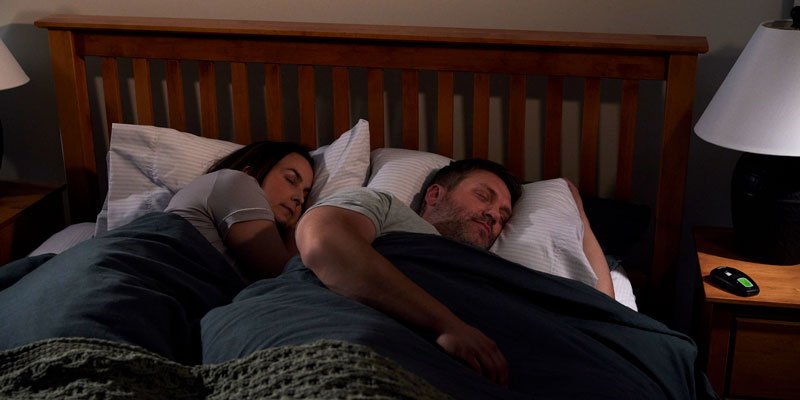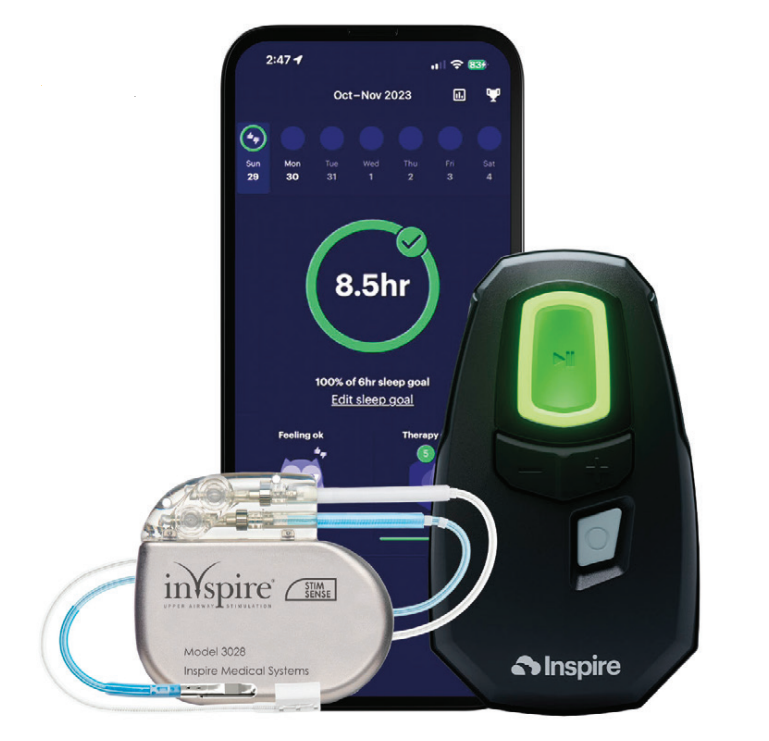Dr. Ian Lalich talks about the Stimulation Therapy for Apnea Reduction (STAR) Trial and how a novel surgical therapy for OSA patients with PAP intolerance has had excellent outcomes compared to other surgical management options.
 A New Paradigm in Surgical Management of Obstructive Sleep Apnea
A New Paradigm in Surgical Management of Obstructive Sleep Apnea
by Ian Lalich, MD
Hypoglossal nerve stimulation (HGNS) therapy is a relatively new Food and Drug Administration (FDA) approved surgical therapy to treat moderate to severe obstructive sleep apnea in positive airway pressure (PAP) therapy intolerant patients. Inspire Medical Systems manufactures the only FDA approved HGNS device in the United States. The device was approved by the FDA in 2014.1 The now famous Stimulation Therapy for Apnea Reduction (STAR) Trial, apnea-hypopnea index (AHI) reduction did show clinically significant improvements in AHI.2 Over the past decade, multiple studies have documented statistically significant improvements in daytime sleepiness, sleep-related quality of life, improvements in oxygen desaturation index (ODI), and bed partner-reported snoring. Patients have been followed for more than 5 years, and the results have been durable. Patient satisfaction and therapy adherence are impressively high compared to other medical therapies for OSA.2-5
The initial STAR trial data shaped the criteria for implant and the procedure itself and have evolved with additional research since the initial FDA approval.2 To qualify for implantation, the FDA requires a drug-induced sleep endoscopy (DISE) procedure to assess for anatomic characteristics favorable to implant. A DISE procedure is performed in the operating room or procedure suite. Patients are given carefully titrated propofol infusion to induce a sleep state while keeping the patient spontaneously breathing. Airway collapse pattern is assessed at velum, oropharynx, tongue base, and epiglottis. The absence of complete concentric collapse at the velum is favorable for hypoglossal nerve stimulator placement.
FDA approval guidelines vary slightly from current Center for Medicare/Medicaid (CMS) Devices guidelines. Currently, patients who qualify for implant must be 18 years old and older, have an AHI between 15-100 (CMS 15-65), a body-mass index (BMI) less than 40 kg/m2 (CMS < 35 kg/m2), must be intolerant to CPAP/BiPAP therapy, and must not show complete concentric collapse (CCC) at the velum on DISE. The apnea and hypopnea events must be primarily obstructive, with less than 25% scoring as central or mixed events. Special consideration for patients with Down Syndrome are approved for patients 13 and older. There have been reports in the literature of patients as young as 4 years old being implanted successfully.6
While seeming straightforward, deciding on PAP intolerance can be quite nuanced. Patients doing well on PAP therapy with good therapeutic outcomes and clinical benefits are not candidates. Patients who like and use PAP therapy but want a surgical option for convenience are not considered appropriate candidates. Patients with poor usage, significant aerophagia, severe leaks despite troubleshooting, dermatologic issues with mask-wearing, recurrent respiratory illness/sinusitis patients, and REM behavior disorder are good candidates. There are patients who are using their therapy but struggle with claustrophobia, insomnia due to PAP therapy, or develop an aversion to therapy. The decision-making for the later group is more difficult and involves careful discussion with the patient. Implementing a multidisciplinary team of sleep providers and otolaryngology providers to discuss patient therapy options is often helpful for decision-making.

The current implant (Inspire IV) is placed with a two-incision approach: a modified submandibular neck utility incision and a sub-clavicular upper chest incision. Placing the device on the right side is preferred, leaving the left side for cardiac devices. Implants can be placed on the left in special situations. Intraoperative electromyography (EMG) mapping of the hypoglossal nerve is performed to select nerve branches that will stiffen/protrude the tongue and exclude branches that will retract and retrude the tongue. The stimulation lead is tunneled to the generator pocket. A breathing sensor is placed between ribs 2 and 3, superficial to the internal intercostals and deep to the external intercostals. The device is tested intraoperatively to assess function. The procedure takes about 1-2 hours and is usually an outpatient procedure. Following implant, the patient must wait a minimum of 4 weeks to allow for healing before activation.
The surgery is well tolerated with much less morbidity than other surgical procedures used to treat obstructive sleep apnea. While not an exhaustive list, surgical risks include surgical site bleeding/hematoma/seroma, pain at incision/generator site, temporary or permanent injury to the ipsilateral hypoglossal nerve, pneumothorax with respiratory sensor placement, delayed device infection/migration/extrusion, device/component malfunction, device recall, and risk of general anesthesia. Recent MAUDE database analysis reviewed the overall complication rate of HGNS placement.7 In 2023, there were a total of 414 complications out of 23,743 implants placed (roughly 1.74%). Approximately 75% of complications involved pain, infection, and hematoma/seroma/edema. Device infection leads to the highest rate of explant (48.6%). The updated complication rate is consistent with the initial complication rates from the STAR trial, which are roughly 2%.2 Overall, HGNS placement is well tolerated and has a low complication rate.

Placement, programming, and follow-up involve a close collaboration between an otolaryngologist and a sleep medicine provider. Following implant and healing, the device is activated by a sleep medicine provider. Initial programming is usually pre-templated, with most patients tolerating traditional programming settings. Functional and presumed therapeutic thresholds are identified during activation/programming. Other programming features allow for delay before therapy initiation, pause duration, and total therapeutic duration. Patients then have an external remote they use to direct their therapy.
Following activation, the patient slowly titrates to their therapeutic threshold. Patients are usually advised to advance the voltage one step per week. Device efficacy is assessed once patients are near their threshold voltage setting, sleep well, and wake refreshed without daytime tiredness. Home sleep studies can be useful to check in on a patient’s progress but do not easily allow assessment of the range of therapeutic options. An in-lab HGNS titration polysomnography study is performed in a manner similar to PAP titration. The AHI is evaluated at different voltage thresholds throughout the night, including the presumed therapeutic threshold based on clinical observation during activation/programming and patient feedback. Being mindful of sleep position and sleep stage during titration allows for the most accurate assessment of therapeutic voltage level. Understanding that therapeutic voltage may be lower than expected is also paramount. Over-titration occurs with the continued increase in voltage in anticipation of further reduction in AHI. The additional energy can lead to current spread and activation of antagonistic musculature, resulting in decreased efficacy and patient discomfort.
Hypoglossal nerve stimulation (HGNS) therapy is a novel surgical therapy for OSA patients with PAP intolerance.
Most patients are therapeutic after the first titration study. If therapeutic voltage was not identified or the therapeutic setting is not well tolerated by the patient, the device can be reprogrammed and the titration process can be repeated. If a therapeutic voltage can not be found or tolerated, complex reprogramming can be performed with combined efforts from the sleep medicine and otolaryngology teams. Performing awake upper airway endoscopy during reprogramming can assist in finding a functional/therapeutic setting that is tolerable. Awake endoscopy may also suggest other changes (head/neck position, body position, mouth posture, et cetera) that would improve the airway.
The current version of the device Inspire IV (Model 3028) has a battery rating of 11 years. Patients with the device require generator change following battery depletion. The device is MRI compatible for full body MRI using the appropriate protocol with a 1.5 Tesla magnet. The device is compatible with air travel and should be declared to the TSA to undergo medical device-compatible screening. In August 2024, the FDA approved Inspire V. The device will have a new Bluetooth-enabled patient remote, a new physician programming device. It will not be necessary to place a respiratory sensor. Battery life, MRI conditionality, and air travel compatibility will remain the same. The company expects wide deployment/adoption of the new device in late 2025/early 2026.
Current outcomes are measured based on overall AHI reduction, patient usage, and symptom improvement. Patients are classified as Green or Yellow Pathway based on their outcome following titration. Green Pathway patients have an overall AHI of less than 15, patient usage greater than 4 hours per night, and subjective improvement in sleep symptoms. Patients not meeting all Green Pathway criteria are classified as Yellow Pathway and undergo reprogramming and re-titration until they meet Green Pathway criteria.
HGNS therapy is a novel surgical therapy for OSA patients with PAP intolerance. The therapy has excellent outcomes compared to other surgical management options with low complication rates. In appropriately selected patients, HGNS therapy is an excellent surgical option for treating obstructive sleep apnea.
This article, by Colonel Scott Williams on the importance of research underscores the need for deeper looks into mandibular advancement therapy and research such as the Stimulation Therapy for Apnea Reduction (STAR) Trial to find out alternative therapies for people who cannot tolerate PAP therapy. For more, click: https://dentalsleeppractice.com/the-importance-of-research/
- Kent DT, Carden KA, Wang L, Lindsell CJ, Ishman SL. Evaluation of Hypoglossal Nerve Stimulation Treatment in Obstructive Sleep Apnea. JAMA Otolaryngol Head Neck Surg. 2019;145(11):1044-1052. doi:10.1001/jamaoto.2019.2723
- Strollo PJ Jr, Soose RJ, Maurer JT, et al. Upper-airway stimulation for obstructive sleep apnea. N Engl J Med. 2014;370(2):139-149. doi:10.1056/NEJMoa1308659
- Woodson BT, Soose RJ, Gillespie MB, et al. Three-Year Outcomes of Cranial Nerve Stimulation for Obstructive Sleep Apnea: The STAR Trial. Otolaryngol Head Neck Surg. 2016;154(1):181-188. doi:10.1177/0194599815616618
- Woodson BT, Strohl KP, Soose RJ, et al. Upper Airway Stimulation for Obstructive Sleep Apnea: 5-Year Outcomes. Otolaryngol Head Neck Surg. 2018;159(1):194-202. doi:10.1177/0194599818762383
- Mashaqi S, Patel SI, Combs D, et al. The Hypoglossal Nerve Stimulation as a Novel Therapy for Treating Obstructive Sleep Apnea-A Literature Review. Int J Environ Res Public Health. 2021;18(4):1642. Published 2021 Feb 9. doi:10.3390/ijerph18041642
- Wasserman I, Chieffe DJ, Gipson KS, Skotko BG, Hartnick CJ. Hypoglossal Nerve Stimulation for Obstructive Sleep Apnea in a Young Child With Down Syndrome. Pediatrics. 2024;153(5):e2023063330. doi:10.1542/peds.2023-063330
- Bentan MA, Nord R. Comprehensive Analysis of Adverse Events Associated With Hypoglossal Nerve Stimulators: Insights From the MAUDE Database. Otolaryngol Head Neck Surg. 2024;171(5):1580-1590. doi:10.1002/ohn.883


 Ian Lalich, MD, is an otolaryngologist based in Minneapolis, MN, who specializes in sleep surgery. He graduated from the University of North Dakota School of Medicine and Health Sciences and completed his residency at the Mayo Clinic College of Medicine and Science, where he also served as a clinical instructor. He currently serves as an attending surgeon at several Minnesota hospitals in the M Health Fairview system. In addition to general otolaryngology, his experience extends to sleep surgery and surgical oncology of the head and neck. He is the recipient of multiple awards including Physician of the Year from M Health Fairview Lakes Medical Center. In 2025, he will assume the role of Medical Director of Otolaryngology-Head and Neck Surgery at M Health Fairview. Dr. Lalich also serves as Vice President of the Minnesota Academy of Otolaryngology.
Ian Lalich, MD, is an otolaryngologist based in Minneapolis, MN, who specializes in sleep surgery. He graduated from the University of North Dakota School of Medicine and Health Sciences and completed his residency at the Mayo Clinic College of Medicine and Science, where he also served as a clinical instructor. He currently serves as an attending surgeon at several Minnesota hospitals in the M Health Fairview system. In addition to general otolaryngology, his experience extends to sleep surgery and surgical oncology of the head and neck. He is the recipient of multiple awards including Physician of the Year from M Health Fairview Lakes Medical Center. In 2025, he will assume the role of Medical Director of Otolaryngology-Head and Neck Surgery at M Health Fairview. Dr. Lalich also serves as Vice President of the Minnesota Academy of Otolaryngology.